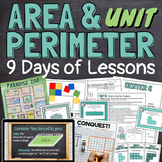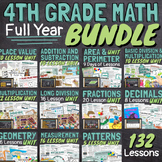Conquest Area and Perimeter With Tiling Practice Math Game
- PDF
What educators are saying
Also included in
- This 9 day area and perimeter math unit includes 9 easy to teach lessons that reinforce 3rd grade area and perimeter concepts and introduce 4th grade common core standards (4.MD.A.3). Skills taught include: what are area and perimeter and how are they measured?finding area and perimeter by tiling anPrice $15.05Original Price $21.50Save $6.45
- This year long fourth grade math bundle includes 132 math lessons spanning 11 different units. All lessons are common core aligned and cover all CCSS standards required for 4th grade math!Begin with each unit guide (these are free and linked below!). The lesson plans will walk you through each unitPrice $156.80Original Price $392.00Save $235.20
Description
In this simple area and perimeter math game, players compete to conquer the most territory on the board. This fast paced game builds conceptual understanding of area and perimeter with concrete modeling (tiling). To play:
- Each player rolls 2 dice and uses the numbers to draw a rectangle on the grid. For example, if you roll a 6 and a 4, you can draw a rectangle that is 6 squares long and 4 squares wide.
- Find the area and perimeter of the rectangle by counting unit squares and write it inside.
- Players continue conquering territory until time is up or until they can no longer fit any more rectangles on the board.
- At the end of the game, players total the areas and perimeters of all their territory and the player with the most territory wins!
Make copies of the game board for each pair and have them use two different colors to mark their territory. Or, laminate copies of the game board and use different colored dry erase markers for a re-usable option.
Three ways to win: largest area, largest perimeter, or most rectangles!
This activity is also included in an 8 day print and go area and perimeter unit for 4th grade available here!
Please follow my store here for more great resources!
You can also find me on Facebook, Instagram, and lafountaineofknowledge.com where you'll discover ideas, inspiration, and plenty of freebies! Or join my email list to get my monthly newsletter with exclusive FREE resources you can't get anywhere else!
Want free money to spend on Teachers Pay Teachers? Rate this product to earn some TpT credit! Leaving feedback helps us both out and takes less than a minute! Your support makes it possible for me to continue making and sharing great resources! Thank you!
Credits: Graphics and photographs by Shea LaFountaine of LaFountaine of Knowledge. Fonts used include Londrina Sketch and Londrina Solid by Marcelo Magalhães, Pangolin by Kevin Burke, and Star Jedi by Boba Font. Fonts used with permission under open source licenses.







